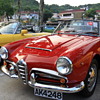Posted 10 years ago
 vetraio50
vetraio50
(756 items)
Tourism began the day after the battle of Waterloo. A Captain Mercer noted that on 19 June “a carriage drove on the ground from Brussels, the inmates of which, alighting, proceeded to examine the field”.
Tourism really began in a big way in 1904 with the opening of the Monument des Français. It was the first recognition of the French dead on the battlefield since 1815. Over 100,000 travelled to the site for the opening of the monument.
"The elevation of this escarpment can still be measured by the height of the two knolls of the two great sepulchres which enclose the road from Genappe to Brussels: one, the English tomb, is on the left; the other, the German tomb, is on the right. There is no French tomb. The whole of that plain is a sepulchre for France."
—Victor Hugo, Les Misérables.
In 1907 Septimus and Clara Miller collected this second card of the Monument to the French soldiers at the Battle of Waterloo. The card shows the first configuration of the French Monument: the monument surrounded by a series of bollards linked with chain. Note too the barbed wire fencing as well!
Around 1912 Sabretache (a French military organisation of the time) surrounded the site with a wrought iron fence. They also remodelled the area around the base of the monument. The land on which it stood had been bought for the construction of a monument by Henry Houssaye, le comte Albert de Mauroy & Gustave Larronet. A few years ago it was handed back to local Belgian authorities at a price of €1.
On the blue stone base is written: Aux derniers Combattants de la Grande Armée.
Three armies were involved in the battle: Napoleon’s Armée du Nord, a multinational army under Wellington and a Prussian army under Blücher.
The French army of around 69,000 consisted of 48,000 infantry, 14,000 cavalry, and 7,000 artillery with 250 guns.
They were volunteers. All of them were veterans from earlier campaigns. The cavalry included fourteen regiments of armoured heavy cavalry and seven of highly versatile lancers.
Waterloo cost Wellington around 15,000 dead or wounded and Blücher some 7,000.
Napoleon lost 25,000 dead or wounded, with 8,000 taken prisoner.
“22 June. This morning I went to visit the field of battle, which is a little beyond the village of Waterloo, on the plateau of Mont-Saint-Jean; but on arrival there the sight was too horrible to behold. I felt sick in the stomach and was obliged to return. The multitude of carcasses, the heaps of wounded men with mangled limbs unable to move, and perishing from not having their wounds dressed or from hunger, as the Allies were, of course, obliged to take their surgeons and waggons with them, formed a spectacle I shall never forget. The wounded, both of the Allies and the French, remain in an equally deplorable state.”
—Major W. E. Frye After Waterloo: Reminiscences of European Travel 1815–1819.
http://en.wikipedia.org/wiki/Battle_of_Waterloo
This is another of the E. Gregoire Series cards Series 5 No. 113.





























Many thanks MOON!!!
The kids who join armies almost always regret it after they see a man torn apart, if it's not them. There is absolutely nothing glamorous about it. That battle was a true carnage. But they all are. Don't go. Just send your money & watch the fools rush in.
Many thanks KAREN, AGHCOLLECT, VIOLET ORANGE & BLUNDERBUSS2 for those pertinent comments.
stunnig postcards Kevin and great history!!
Many thanks INKY, SEAN, BRATJDD & TOM!!!
Many thanks POPS & WALKSOFTLY too!!!
Many thanks MIKELV!!!!
All of your card images, history and consideration are just wonderful! What a collection you should write a book.
Many thanks DON, FLEDERMAUS 'n GEO too!!!
Many thanks TREY 'n GARY too!!!!
Many thanks KERRY10456!!!
Many thanks ANTIQUEROSE!!!
Many thanks MANIKIN & RADEGRUNDER !!!!!
Many thanks PETEY !!!!
Many thanks MIKKO!!!!!!
Many thanks NORDICMAN !!!!!
Many thanks CAPERKID !!! ! !!!